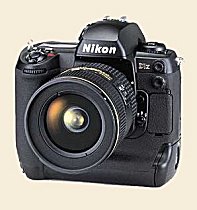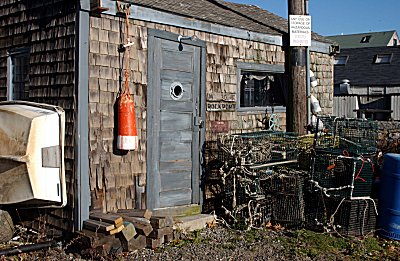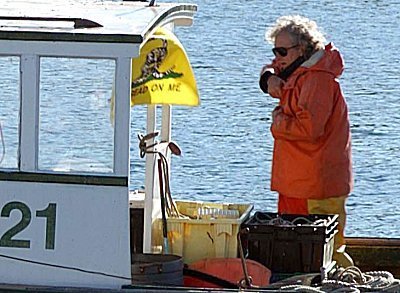D1x: Nikon's
flagship 5.33 megapixel digital SLR
by Vivid Light Staff
 Overview Overview
It's a little before 6AM in Rockport Mass. A damp cold wind is blowing
steadily off the ocean onto the bow of the lobster boat I'm shooting. The
temperature is finally climbing up into the high 30s. For the last hour
I've been telling myself that if I don't think about the cold I'll forget
about it but my fingers are telling me I'm a friggin' nuts. My body just
hasn't adjusted to this winter stuff yet.
But what's really on my mind is the fact that shooting with a D1x is
just like, well, shooting with any other pro camera. A fact that is pretty
startling for a digital camera. So much so that I'm beginning to think
there may finally be a permanent place for a digital in my camera bag
(well maybe if a spare six grand shows up in my wallet). One of the things
that has me convinced is that I'm shooting the D1x side by side with an
F100 (to get matching comparison images) and switching between the two
cameras is virtually seamless.
 The D1x operates just like any pro film camera. All the tactile cues
are there - the way the dials work, the way the lens mounts, the feel of
the shutter, and the sound of the shutter all feel right. Many digital
cameras simply feel foreign in the hands of an experienced photographer. I
remember reading an article by one pundit who claimed digital would
be liberating. You could change every part of the camera's controls
because you weren't married to the limits of the film SLR design. But what
we've discovered is that many of these so called "improvements"
actually made cameras harder or less satisfying to use. There is a reason
SLRs grew to work the way they do and their shapes have been sculpted by
utility. Hence the movement to make digitals more like SLRs. With the D1x
the transition between digital and film is nearly seamless. The D1x operates just like any pro film camera. All the tactile cues
are there - the way the dials work, the way the lens mounts, the feel of
the shutter, and the sound of the shutter all feel right. Many digital
cameras simply feel foreign in the hands of an experienced photographer. I
remember reading an article by one pundit who claimed digital would
be liberating. You could change every part of the camera's controls
because you weren't married to the limits of the film SLR design. But what
we've discovered is that many of these so called "improvements"
actually made cameras harder or less satisfying to use. There is a reason
SLRs grew to work the way they do and their shapes have been sculpted by
utility. Hence the movement to make digitals more like SLRs. With the D1x
the transition between digital and film is nearly seamless.
 One very pleasant surprise with this camera was learning that in most
situations you can trust it's meter. With many digitals photographers wind
up doing a lot of "chimping" - flipping the camera over and
checking the LCD between every shot (watch someone do this and you'll
understand the reference to looking like a chimp). Photographers get into
this habit for two reasons: first because they can, second because they've
learned to be a bit suspicious of their meters. One very pleasant surprise with this camera was learning that in most
situations you can trust it's meter. With many digitals photographers wind
up doing a lot of "chimping" - flipping the camera over and
checking the LCD between every shot (watch someone do this and you'll
understand the reference to looking like a chimp). Photographers get into
this habit for two reasons: first because they can, second because they've
learned to be a bit suspicious of their meters.
The D1x uses Nikon's 3D matrix metering with a 1,005 pixel RGB color
meter (from the F5) that is extremely accurate in in most situations and
gives you three metering modes to choose from; 3D matrix, center weighted,
and spot. You can choose to shoot in Program, aperture or shutter priority
and you can dial-in plus or minus 5 stops of exposure compensation in
1/3rd or 1/2 stop increments.
 In Salem we came across an old church converted to a private residence
for someone with "unique" architectural tastes. The church had
been painted black, it's stained glass blacked out. Four large black
gargoyles were placed on the steps. In open shade the D1X had no problem
correctly metering the black gargoyles against the black doors to maintain
detail in both. The same was true in the soft morning light with the
lobster boats and in bright sunlight later in the day. In Salem we came across an old church converted to a private residence
for someone with "unique" architectural tastes. The church had
been painted black, it's stained glass blacked out. Four large black
gargoyles were placed on the steps. In open shade the D1X had no problem
correctly metering the black gargoyles against the black doors to maintain
detail in both. The same was true in the soft morning light with the
lobster boats and in bright sunlight later in the day.
Where the meter did show a bias was in strongly backlit scenes where it
tended towards under exposure - even in spot meter mode. We found that a
full stop to a stop and a half exposure compensation was necessary to get
proper exposure with one particular strongly backlit subject. As we became
more familiar with the camera we found that strong backlighting was the
one time when we really needed to use the LCD to check exposure otherwise
we had faith in the meter. Where we bracketed exposures we found that the
meter's original reading was best.
We had a similar experience with the auto white balance control. The
D1x evaluates information from the color meter along with information from
the CCD to measure the color temperature of the available light. From that
information it sets what it feels is the optimum white balance. We found
this system worked well in almost all conditions we shot under. Almost
because it didn't always detect indoor lighting correctly, requiring the
photographer to switch over to the incandescent setting manually.
Focus speed and tracking were fast and accurate as expected. The D1X
uses the same Multi-CAM 1300 focus system that has been well tested and
proven in the D1, F5 and F100. Focus tracking was unperturbed when
stationary objects came between the camera and the subject even when
shooting in low light.
All this technology conspires to capture a sharp, correctly exposed
5.33 megapixel image. 5.33 megapixels translates into a 3,008 x 1,960
pixel image. More than enough resolution for magazine work, including full
and multi-page spreads. Teamed with Genuine Fractals, images from the D1x
can be blown up to 11x14 and even wall size prints with stunning results.
At these resolutions it starts to become impossible to tell if the origin
of the image was digital or film.

Images can be captured and stored as
JPEG, TIFF, or NEF files. NEF is Nikon's proprietary raw data file format.
The D1x is bundled with a PhotoShop compatible plug-in that allows you to
bring NEF files directly into your image editing program (a somewhat slow
process). But the real power of raw files can only be exploited if you
purchase the optional Nikon Capture 2 software (more on that later).
Interestingly the CCD actually captures 5.47 megapixels of data to
create the 5.33 megapixel image. The additional information is used for
metering and image quality control. Speaking of image quality, Nikon has
gone through this camera from top to bottom eliminating any areas where
noise might creep into the image during long exposures. The result is
nearly noise free night images even at ISO 800.


One question that comes up a lot is whether the difference in effective
focal length is an issue when shooting with digital SLRs. Because the CCD
is smaller than the size of a 35mm frame the effective focal length is
1.5x the actual focal length of the lens. In other words a 20mm lens on
the D1X is the equivalent of shooting with a 30mm lens and a 300mm lens is
the equivalent of shooting with a 450mm lens. In actual use it simply
ceases to be an issue provided you already have a lens or lenses to cover
the super-wide focal lengths. If not you'll want to add one to your
arsenal for use with the D1X.
User controls are, as we said, straightforward. The top deck is
virtually the same as the F100 with controls for exposure compensation,
flash, and ISO clearly visible. The most used functions are controlled by
the now familiar combination of pressing a button while turning a control
dial. Less used digital functions are controlled using menu buttons
located behind a small metal door on the back of the camera under the LCD.
These buttons bring up a menu on the LCD that you navigate using the touch
pad and buttons to control settings such as image quality, white balance,
sharpness, and saturation. If you've ever used a digital camera before you
can navigate around the D1x's menus and only rarely need to go back to the
manual for confirmation on controls.
Image previews are obtained by pressing the preview button just above
the LCD which now shows 100% of the captured image.
The D1x is bundled with a single EN-4 NiMH battery and a MH-16 charger.
Additional EN-4 batteries are available as well as the MH-17 car charger.
We found battery life with the D1x to be a virtual non-issue and when the
battery indicator showed signs that the battery was getting low, 90
minutes on the charger (often less) brought it back up to full charge.
The standard flash for the D1x is the SB-28DX. This flash is
functionally identical to the SB28 when used with any of Nikon's
non-digital cameras. But the DX version is required for 3D Multi-sensor
balanced fill flash with the D1x and D1h. This flash also provides a
speedy 1/8000th of a second flash sync speed. Also compatible with the D1
series of cameras is the compact SB-50 DX flash. We would expect that all
new Nikon flashes introduced from here on will be DX flashes, compatible
with both film and digital SLRs.
 When using one of these two flashes, the D1x uses a five-segment TTL
multi-sensor to read a series of monitor pre-flashes off the shutter's
gray surface. Programmed reflectance values are compared to the flash
reading in order to determine the subject's reflectance and compensate for
potential over or under exposure. The D1x allows you to vary both exposure
and flash exposure to get the desired image. When using one of these two flashes, the D1x uses a five-segment TTL
multi-sensor to read a series of monitor pre-flashes off the shutter's
gray surface. Programmed reflectance values are compared to the flash
reading in order to determine the subject's reflectance and compensate for
potential over or under exposure. The D1x allows you to vary both exposure
and flash exposure to get the desired image.
The camera is bundled with Nikon View 4.0 for reading images directly
from memory cards or from the camera itself using firewire (IEEE 1394).
This software allows you to view image thumbnails and move files off the
memory card directly onto disk. Additionally Nikon offers software called
Capture 2. This software allows you to work directly with raw mode files.
The advantage here is that many of the digital settings (such as white
balance, and tone) are applied to the image after it is
captured. The raw mode file captures the original image as it was captured
by the CCD with the camera settings included in the file format. The
Capture 2 software allows you to manipulate these settings hours, days, or
years after the image is captured, and perhaps, after you have a better
understanding of the effects of these settings. This utility doesn't come
cheap however. The Capture 2 software has a list price of $225. Given the
list price of the camera and the immense utility of the software you do
wonder why Nikon didn't simply include it with the D1x.
Economy
A potential downside for many photographers is the cost of the camera.
List is $6,300 and we found street prices averaging around $5,500 with
prices as low as $5,350 being fairly common. While that sounds pretty
pricey at first blush you have to consider the fact that you are, in
effect, eliminating film costs. Let's say your average cost for film and
processing for a roll of slide film is $12. Assuming a cost of $5,500 that
means the D1X pays for itself after about 460 rolls of film. If you're
shooting 38 rolls a month, not a lot for many pros, that means the D1X
pays for itself in the first year (not including the cost of additional
memory cards).
Conclusion
 The experience of using the D1X is more like using a "camera"
than any other digital we've tried so far. It's chief competitors will be
the new Canon 1D. Which camera appeals to you the most will probably
depend to a great degree on what system you're currently using.
The experience of using the D1X is more like using a "camera"
than any other digital we've tried so far. It's chief competitors will be
the new Canon 1D. Which camera appeals to you the most will probably
depend to a great degree on what system you're currently using.
If you're a working pro the economy and practicality of the D1X are
immediately obvious. It looks, feels and handles like a high end SLR which
shortens the learning curve in moving to digital; and the ability to have
what is in effect post processing control can be nothing short of a
Godsend if the worst happens. That's why we can say that even at $6,000
the new generation of digital cameras and the D1X in particular are a
bargain.
 SB-28DX
AF TTL Speedlight SB-28DX
AF TTL Speedlight
We also got the chance to try out
the SB-28DX with the D1X. There are really no surprises here for
anyone who has used Nikon's current top of the line SB-28 flash.
Externally it is virtually the same unit except for the color of the
buttons - a useful visual cue if you're carrying both units in your
bag as we were. The instructions included with the flash are even
SB-28 instructions!
Used with film cameras such as the N80 or F5 the SB-28DX
functions identically to the SB-28. Used with the D1x or D1h however
the SB-28DX allows you to use 3D Multi-Sensor balanced fill flash -
unavailable with the either of the D1 cameras and a standard SB-28.
For those of you unfamiliar with the SB-28 here is a short summary
of it's features:
- 3D Multi-sensor balanced fill flash with monitor pre-flash
with compatible Nikon bodies using D lenses.
- Multi-sensor balanced fill flash, Matrix balanced fill flash,
TTL and manual flash modes supported.
- Slow sync, rear curtain sync, and red eye reduction modes with
compatible camera bodies.
- 1/4000th of a second high speed flash sync with film cameras,
and 1/8000th of a second flash sync with D1 series cameras
- AF assist illuminator LED to assist focus in up to total
darkness.
- Repeating flash mode
- Auto zoom head from 24mm to 85mm and flash diffuser for use
with wide angle lenses.
- Built in bounce card
- Tilt/rotate flash head
- Recycle time approximately 4 to 7.5 seconds depending on power
source
Power: Four AA batteries or optional power pack
Guide Number: 164
|
 Subscribe to
Vivid Light
Subscribe to
Vivid Light
Photography by email
|
